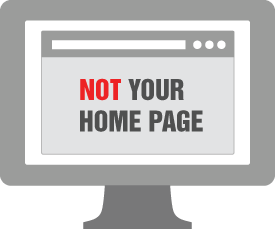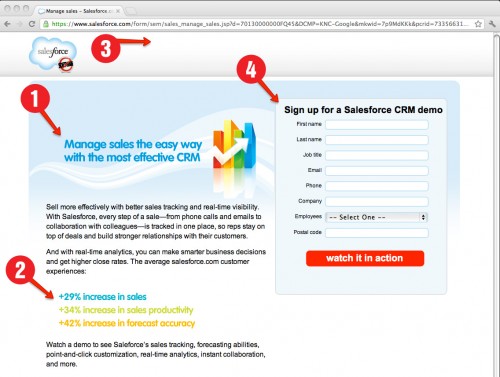At Gorilla, we work primarily with B2B companies – often service providers in the building and construction space – on developing their brand image and capturing leads. In these industries, we see a lot of missed opportunity as far as web marketing goes, and landing pages are one of those glaring opportunities.
If it’s a term you’re not familiar with, no worries. Read on. If you are familiar, but could use some pointers, hopefully there are a few tips below that can help.
 A landing page is not your home page
A landing page is not your home page
So what is it then?
In short, it’s a page on your website that’s designed for lead capture. It’s built as a destination for a specific audience, and is focused on a topic specifically relevant to that audience. You might send a visitor there from any of the following:
- A unique URL that you list on a print ad
- An email blast
- Facebook, LinkedIn, Twitter or other social media
- A pay-per-click ad in Google
- A web banner ad on another website
- Another page on your own site
So why wouldn’t you just send visitors to your home page?
First of all, a good landing page allows you to segment the different audiences your company is targeting and put the most relevant information in front of each of them. If you’re a construction company focused on building both churches and banks, you’d want to talk to each of those audiences differently, right? Directing them to pages that are unique to their needs is much more efficient that sending them to a more generalized home page.
Secondly, a good landing page gives you a better chance of moving that audience member into your sales funnel. If the page is constructed with thought, it’s been designed to capture leads. The page is architected to keep the visitor focused on the topic that brought them to your site. The content on that page is meant to validate you in the visitor’s eyes, put you in their consideration set and encourage them to get in touch with you.
Let’s look at an example
Salesforce is a CRM (customer relationship management) software that helps you manage contacts, follow leads, set reminders, etc. They use some very simple, yet effective landing pages for people looking for a CRM software.
Below is a screenshot, marked with four things that make it smart. This of course is a software product, but there are valuable takeaways here for any B2B service-based company.
 Identify the topic
Identify the topic
The first thing your eye is drawn to on the page is a very short, clear headline that identifies the topic of this page. If you got here by clicking an ad or link that was promoting a CRM software, you know immediately that you’ve landed on a relevant page.
 State your benefits
State your benefits
An article about effective landing pages on SearchEngineLand.com says “All marketers tend to focus on how great their company is, but business buyers want to know “what’s in it for me”. ” A landing page should be written to best suit the mindset of your audience. How can the service you provide satisfy their need?
 Keep the visitor focused
Keep the visitor focused
The visitor arrived on this specific page for a reason. They expressed interest on the topic at hand, and the page keeps them focused on that topic. In this example, Salesforce went as far as to remove their site’s main navigation. They’ve put the most relevant information in front of their visitor and nothing more.
 Call to action
Call to action
This is the most important element of a landing page. The page was built to encourage a targeted member of your audience to do something. Whether that something is contacting you for more info, signing up for your newsletter, buying a product, or anything else, the page needs to encourage the visitor to take action so you can further engage them.
A lead-capture form is the classic landing page call-to-action. Marketing software company Hubspot says, “Your goal should be to collect enough information through your form to enable you to both contact and qualify the lead.” Listing a big phone number and email address is never a bad idea either.
In summary
Landing pages are about smart, targeted marketing, and they are a huge part of your overall B2B website design. Though there’s a science to them, a lot of it is just common sense. Target your audience, give them the most relevant info and encourage them to get in touch.
